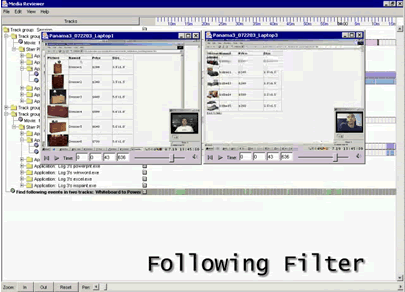 |
|||||||||||
|
Media Reviewer
The Interactive Cognition Lab, in collaboration with Dave Nadeau of the San Diego Supercomputer Center, has designed the Media Reviewer to help researchers review, annotate, and analyze data collected during a user study.
Software
Demo |
||
|
||
Tracks
The tool arranges data events along a horizontal timeline. An event may
note when a subject spoke, gestured, used a program or took action. Each
event describes what action occurred and when. Events are arranged along
horizontal tracks which can be grouped together and shown or hidden as
a unit. There are several types of tracks supported by the Media Reviewer.
| • | An annotation track shows events authored by the researcher. |
| • | A movie track automatically creates its events by detecting when a subject is speaking. Each movie in its track can be played. When there are several movie tracks, all the movies can be played at the same time and in sync. |
| • | A logging track automatically creates a group of tracks with events read from a computer activity log. The log’s events record a subject’s keystrokes, webpage selections, and application use. |
|
|||||
 |
 |
||||
|
|||||
Filters
for Analyzing Data
To analyze data, the Media Reviewer provides a large selection of data
mining filters. Each filter scans one or more tracks to find events that
match a pattern.
| • | The rapid event filter detects a quick series of events. This can highlight rapid action such as a subject quickly clicking through a chain webpages. |
| • | An overlap filter detects simultaneous activity. |
| • | A following filter detects when events on one track follow events on another. The same filter can highlight when one subject follows another’s lead. |
Additional filters detect simultaneous and disjoint events, chains of alternating activity, and times when nothing happens at all. Filters can be used in combination to detect complex interactions.
|
|
 |
|
|
The Media Reviewer is a powerful tool for annotating and analyzing data to reveal patterns in the way we act and interact.
|
|




